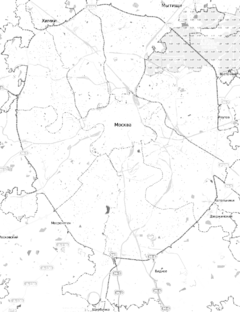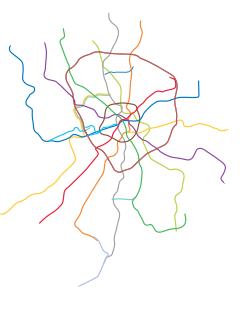Kolomenskaya (Moscow Metro)
Kolomenskaya | |||||||||||
|---|---|---|---|---|---|---|---|---|---|---|---|
| Moscow Metro station | |||||||||||
 | |||||||||||
| General information | |||||||||||
| Coordinates | 55°40′43″N 37°39′50″E / 55.6785°N 37.6638°E | ||||||||||
| Owned by | Moskovsky Metropoliten | ||||||||||
| Line(s) | |||||||||||
| Platforms | 1 island platform | ||||||||||
| Tracks | 2 | ||||||||||
| Connections | Bus: 148, 156, 216, 219, 221, 263, 263e, 287, 291, 299, 608, 670, 670k, 701, 724, 751, 820, 820d Trolleybus: 46, 67 Tram: 35, 35k, 47, 47k | ||||||||||
| Construction | |||||||||||
| Depth | 9 metres (30 ft) | ||||||||||
| Platform levels | 1 | ||||||||||
| Parking | No | ||||||||||
| Other information | |||||||||||
| Station code | 028 | ||||||||||
| History | |||||||||||
| Opened | 11 August 1969 | ||||||||||
| Services | |||||||||||
| |||||||||||
| Location | |||||||||||
Kolomenskaya (Russian: Коло́менская) is an underground metro station on the Zamoskvoretskaya Line of the Moscow Metro in Moscow, Russia.
History
Kolomenskaya Station was opened on 11 August 1969 as a part of the southern line extension of the Moscow Metro system.
Design
Kolomenskaya was named after the nearby Kolomenskoye museum-park.[1]
Octagonal pillars of the station hall are lined with grey marble and the floor is riveted with red granite in the centre and grey granite at the sides. The track walls are faced with yellow ceramic tiles with a stripe of grey marble at the base. The station is adorned with copper plaques on the theme How Motherland began (sculptor E.Ladygin)[1]

Exits
The station has two underground vestibules, located on the intersection between the Andropova avenue and the Nagatinskaya/Novinki street. Both vestibules are interlinked with underpasses that offer exits to the surface level which covered glazed pavilions.
Surrounding area
The construction of the station is a typical example of Soviet urban development, as the apartment blocks that were built around it are contemporary with the station. The region that the is located in, Nagatino became part of Moscow only a few years prior to the construction of the station. Part of the track from Avtozavodskaya is above ground, and it passes over the Moskva River on the Nagatinsky Metro Bridge which was opened simultaneously with the new segment. Plans for a new station, Tekhnopark (alternative name, Prospekt Andropova) to be added in the future remains unfulfilled.
References
- ^ a b "Information on Moscow Metro site". Moskovsky Metropoliten (in Russian). Retrieved 31 December 2011.


